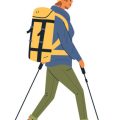1. Choosing the Right Gear
When it comes to day hiking across the diverse landscapes of the United States, having the right gear can make or break your adventure. From the misty forests of the Pacific Northwest to the sun-drenched deserts of the Southwest, what you wear and carry plays a big part in your comfort and safety. Here’s an overview of essential clothing, footwear, and backpacks designed for different American terrains and climates.
Clothing Essentials: Layer Up for Any Weather
The weather in the U.S. can change quickly—especially in mountainous regions or coastal areas. Dressing in layers is key so you can adjust as conditions change throughout your hike.
| Layer | Purpose | Recommended Material | Ideal For |
|---|---|---|---|
| Base Layer | Wicks moisture from skin | Synthetic or Merino wool | All climates |
| Mid Layer | Provides insulation | Fleece or lightweight down | Cool to cold temps (mountains, forests) |
| Outer Layer (Shell) | Protects against wind/rain | Waterproof/breathable shell (Gore-Tex, similar) | Rainy or windy areas (Pacific Northwest, Rockies) |
| Pants/Shorts | Comfort & mobility | Nylon or polyester blends | Varies by season/region (convertible pants are handy) |
| Sun Protection Layer | Shields from UV rays | UPF-rated long sleeves & hats | Deserts, high elevations (Southwest, Rockies) |
Footwear: Find Your Perfect Fit
Your feet do all the hard work on a hike, so choosing the right footwear is crucial. Consider the terrain and climate where you’ll be hiking:
| Shoe Type | Best For | Main Features |
|---|---|---|
| Trail Runners | Packed/dry trails, short hikes, warm climates (California coast, Midwest woods) | Lightweight, breathable, flexible sole |
| Hiking Shoes | Mildly rugged trails, mixed terrain (Appalachian foothills, Great Lakes) | Cushioning, better grip than sneakers, low-cut design for mobility |
| Hiking Boots | Rocky/uneven ground, wet or snowy conditions (Rockies, Pacific Northwest) | Ankle support, waterproofing, tough soles for stability and protection |
| Sandals with Toe Protection | Muddy/swampy areas, water crossings (Southeast wetlands) | Quick-drying material, toe guards for safety |
Packs: Carry Only What You Need
How to Choose a Daypack:
- Capacity: 15-30 liters is perfect for day hikes—enough for snacks, water, extra clothing, and small essentials.
- Fit: Look for padded shoulder straps and a hip belt for comfort. Adjustable straps help customize the fit.
- Pockets: External mesh pockets hold water bottles; zippered compartments keep gear organized.
| Packing Tip By Region | Packing Suggestion |
|---|---|
| Northeast & Pacific Northwest | Add a rain cover for your pack |
| Southeast & Southwest | Cushioned hip belt helps in hot weather when carrying extra water |
| Mountain West | Add an emergency blanket/light jacket for sudden temperature drops |
The Bottom Line on Gear Choice:
Your gear should match where you’re going—and always keep comfort and safety at the top of your list. With these basics in mind, you’ll be ready to hit any American trail with confidence!
2. Navigation and Safety
Must-Have Navigation Tools for Day Hikers
When youre out on the trail, knowing where you are and how to get back is key to a safe and enjoyable hike. While many U.S. hiking trails are well-marked, its always smart to bring your own navigation tools. Here’s a quick look at the must-haves:
| Tool | What It Does | Pro Tips |
|---|---|---|
| Map (Paper) | Shows trails, terrain, and landmarks even when theres no cell service. | Always keep it in a waterproof bag or ziplock. |
| Compass | Helps you figure out direction if you lose your way or if weather turns bad. | Know how to use it before heading out. Practice at home! |
| GPS Device/App | Pinpoints your location and tracks your route using satellites. | Download maps for offline use; bring extra batteries or a power bank. |
| Trail Guidebook | Offers detailed info about the area, points of interest, and warnings. | Check for recent updates or editions for accurate info. |
Safety Tips for Popular U.S. Hiking Regions
The United States is home to a huge variety of landscapes—from desert canyons to alpine forests. Here are some region-specific safety tips every hiker should know:
| Region | Main Hazards | Safety Tips |
|---|---|---|
| Rocky Mountains (CO, WY, MT) | Sudden weather changes, altitude sickness, wildlife encounters (bears, moose). | Pace yourself, check weather reports, carry bear spray, and store food properly. |
| Desert Southwest (AZ, UT) | Extreme heat, dehydration, flash floods. | Start early, carry plenty of water (at least 1 gallon per person), avoid narrow canyons during rain forecasts. |
| Pacific Northwest (WA, OR) | Muddy trails, dense forests, hypothermia risk from wet conditions. | Wear waterproof boots/clothing and bring extra layers even in summer. |
| Appalachian Trail (GA-ME) | Ticks (Lyme disease), unpredictable storms, slippery rocks. | Use insect repellent, wear long sleeves/pants, watch your footing especially after rain. |
Navigating Like a Pro: Simple Steps
- Plan Ahead: Study the trail map before you go. Mark important waypoints like water sources or shelters.
- Tell Someone: Let a friend or family member know where you’re going and when you’ll be back.
- Stay On Marked Trails: Avoid shortcuts that could lead you off course or into dangerous areas.
- If Lost: Stop moving. Use your map and compass to reorient yourself. If needed, use your whistle (three blasts) as a distress signal.
Your Navigation & Safety Checklist:
- Pocket-sized map of the area
- Laminated cheat sheet for compass basics
- Fully charged GPS device/phone with offline maps downloaded
- Sunscreen and hat for sun protection in open areas
- Bearing in mind local hazards—every U.S. region is unique!
Navigating safely ensures every day hike ends with great memories instead of worries. Stay smart out there!

3. Food, Water, and Nutrition
Smart Snacks for Energy on the Trail
Day hiking takes energy, so packing the right snacks is key. Aim for foods that are lightweight, non-perishable, and easy to eat on the go. Mix carbs for quick energy with proteins and healthy fats to keep you full. Here’s a handy table of popular American trail snacks:
| Snack | Why It’s Great |
|---|---|
| Trail mix (nuts, dried fruit, chocolate) | High energy, easy to pack, customizable |
| Granola or protein bars | No mess, portion controlled, lots of flavors |
| Beef jerky or turkey sticks | Packed with protein, long shelf life |
| Peanut butter packets | Rich in protein & healthy fats, spreadable on crackers or apples |
| Dried fruit (apricots, raisins) | Naturally sweet, quick carbs for energy boosts |
| Tortillas with tuna/chicken salad pouches | Hearty lunch option, no refrigeration needed |
Staying Hydrated: Water Matters!
Bringing enough water is crucial—dehydration can sneak up fast. Most hikers need about half a liter (16 oz) per hour of moderate activity in mild temperatures, more if it’s hot or the trail is strenuous. Consider these hydration methods:
| Hydration System | Pros | Cons |
|---|---|---|
| Water bottles (Nalgene, stainless steel) | Durable, easy to refill & clean | May be bulky; harder to drink while moving |
| Hydration reservoirs/bladders (CamelBak) | Hands-free drinking; fits in most packs | Tougher to clean; can puncture |
Pro Tip:
If you’re hiking somewhere new in the U.S., check park websites or visitor centers for info on water availability and safety. Never assume streams are safe—carry a filter or purification tablets if you’ll need to refill from natural sources.
Navigating Local Water Regulations & Safety Tips
The U.S. has many beautiful hiking regions, but rules about water sources can vary. Some parks have strict guidelines to protect fragile ecosystems or prevent pollution. Here’s what to keep in mind:
- No Trace Left Behind: Don’t wash dishes or bathe directly in lakes or streams.
- Purify All Natural Water: Use filters or iodine tablets even if water looks clear—bacteria like Giardia are common.
- Campsite Rules: In some areas, carrying all your own water may be required due to dry conditions or regulations.
Quick Checklist: Food & Hydration Essentials for Day Hikes
- Sufficient water (or filter if allowed/needed)
- A variety of high-energy snacks/lunches
- A lightweight trash bag (pack out everything!)
With a little planning and the right choices, you’ll stay fueled and refreshed for any day hike adventure across America’s trails!
4. Weather Readiness and Emergency Preparedness
Understanding American Weather Patterns
Before you hit the trail, it’s important to know what kind of weather you might face. In the U.S., conditions can change quickly depending on where you hike. For example, mountain regions like the Rockies or Appalachians can have sunny mornings that turn stormy by afternoon. Always check trusted sources like the National Weather Service or local park websites for up-to-date forecasts.
Popular U.S. Weather Apps
| App Name | Features | Best For |
|---|---|---|
| Weather Underground | Detailed hourly & radar info | All-around use |
| NOAA Weather Radar Live | Official government alerts | National parks & remote areas |
| The Weather Channel | User-friendly, maps & videos | Beginners & casual hikers |
Dealing with Sudden Weather Changes
Even with planning, unexpected weather is part of hiking life—especially in places like Colorado or the Pacific Northwest. Pack extra layers (like a rain jacket), a hat, and gloves, even if it looks clear outside. If you see clouds building or hear thunder, turn back or seek shelter right away. Learn basic signs of changing weather, such as dropping temperatures or fast-moving dark clouds.
Packing for Emergencies: Must-Have Items
| Item | Why You Need It | U.S. Example Brand/Type |
|---|---|---|
| First-Aid Kit | Treats cuts, blisters, bites, and more | Adventure Medical Kits Ultralight/Watertight .7 |
| Emergency Blanket (Space Blanket) | Keeps you warm if stuck overnight or in cold rain/snow | SOL Emergency Blanket |
| Headlamp or Flashlight (with batteries) | If you get caught out after dark or in low visibility | Petzl Tikkina Headlamp / Maglite Mini Flashlight |
| Whistle | For signaling if lost or injured (sound carries farther than shouting) | Fox 40 Classic Whistle (often included on backpack straps) |
| Map & Compass (or GPS device) | If your phone dies or loses service, these help you find your way out safely | Suunto A-10 Compass / Garmin eTrex GPS unit |
| Multi-tool or Knife | Cuts moleskin for blisters, repairs gear, and more in emergencies | Leatherman Multi-Tool / Swiss Army Knife Classic SD |
| Sunscreen & Lip Balm (SPF 30+) | The sun is strong at high elevations and open trails—even on cloudy days! | Neutrogena Sport Face / Burt’s Bees SPF Lip Balm |
Quick Tips for Staying Safe:
- Tell someone your plan: Share your hiking route and expected return time with a friend.
- Pace yourself: Don’t rush—tired hikers make more mistakes.
- If lost: Stay put, signal for help with your whistle or bright clothing, and stay warm.
If you’re prepared for all kinds of weather and carry basic emergency gear, day hiking across America’s wild spaces becomes safer and a lot more fun!
5. Leave No Trace and Trail Etiquette
When exploring Americas incredible trails and national parks, its important to hike responsibly. Following the Leave No Trace principles and understanding trail etiquette helps protect nature and ensures everyone has a great outdoor experience. Here’s what you need to know:
Key Principles of Leave No Trace
| Principle | What It Means |
|---|---|
| Plan Ahead and Prepare | Know the area, check the weather, bring the right gear, and learn the rules for your destination. |
| Travel and Camp on Durable Surfaces | Stay on marked trails to avoid damaging plants and soil. Don’t create new paths. |
| Dispose of Waste Properly | Pack out all trash, leftover food, and litter. Use restrooms or bury waste if necessary. |
| Leave What You Find | Don’t pick flowers or take rocks as souvenirs. Preserve history and natural beauty for others. |
| Minimize Campfire Impact | If fires are allowed, use established fire rings and keep them small. Consider using a camp stove instead. |
| Respect Wildlife | Observe animals from a distance. Don’t feed wildlife—human food can harm them. |
| Be Considerate of Other Visitors | Keep noise down, yield to others on the trail, and let everyone enjoy the peace of nature. |
Cultural Trail Manners in U.S. Hiking Areas
- Yielding Right-of-Way: Uphill hikers have the right-of-way. Step aside for those climbing up.
- Bikers and Horses: Hikers yield to horses; bikers yield to both hikers and horses.
- Packing Out Trash: “Pack it in, pack it out” is standard—leave no litter behind, not even fruit peels or biodegradable items.
- Quiet Enjoyment: Keep voices low and music off or use headphones so everyone can enjoy nature’s sounds.
- Group Size: If hiking with a group, walk single file on narrow trails to avoid blocking others.
- Trail Markings: Don’t move rocks or sticks that mark trails; these guide other hikers safely.
- No Shortcuts: Stick to established switchbacks to prevent erosion and protect plants.
- Pets: Keep dogs leashed and pick up after them. Some trails don’t allow pets—check ahead of time.
Quick Reference: Trail Etiquette Do’s & Don’ts
| Do’s | Don’ts |
|---|---|
| Stay on trails Yield to uphill hikers Pack out trash Leash your dog Respect quiet spaces |
Create new paths Leave trash behind Let pets run loose Play loud music Feed wildlife |
Your Role as a Responsible Hiker
The best way to ensure America’s wild places stay beautiful is by practicing Leave No Trace principles every time you hit the trail. Not only does this help protect nature, but it also makes hiking more enjoyable for everyone!


